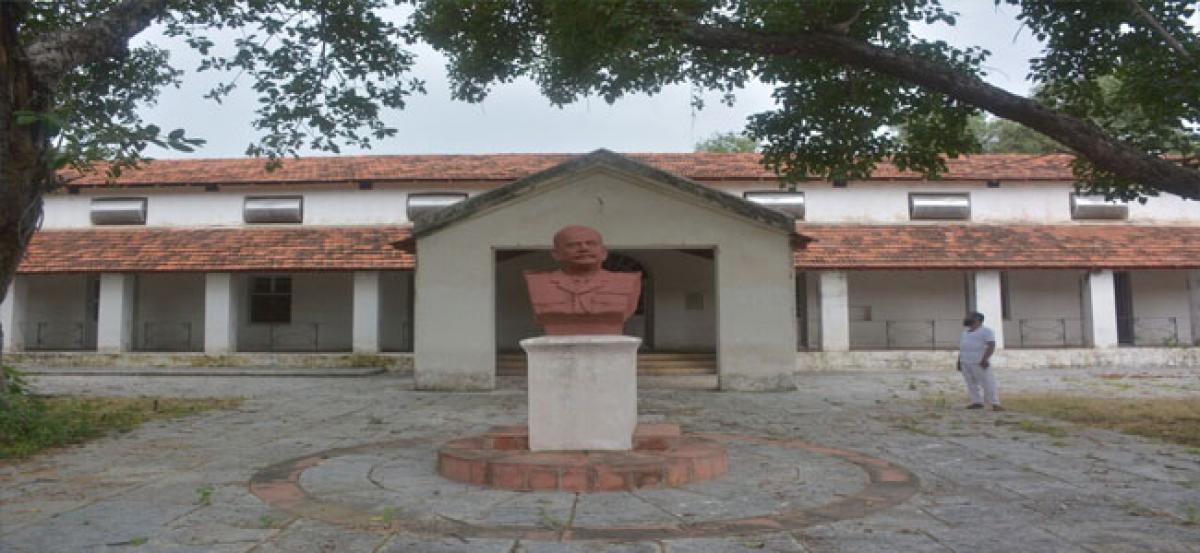Live
- Chess Olympiad: India script history with two gold medals
- Celebrity Couple Srikanth Kidambi and Shravya Varma Visit Gowri Signatures Store
- BJP failed to address civic issues of Gurugram: Raj Babbar
- Killing of fishermen in sea stopped after Modi govt assumed office: Union Minister L Murugan
- PM Modi’s rally venue Nassau Coliseum has hosted legendary entertainers & politicians
- Grand Alumni Reunion Celebration
- Union Minister Scindia seeks action in Tirupati Balaji prasad scandal
- Punjab Government is likely to reshuffle its cabinet on 23rd September, 4-5 new minister will include
- Forum in Thailand calls for boosting globalisation of TCM
- Proteas hoping to 'go one step further' and lift Women's T20 WC: Wolvaardt
Just In

Sir Ronald Ross Institute of Parasitology situated in Begumpet has become an establishment only in name, yet to be institutionalised in the real sense of the term. The place that has been witness to the discovery of malarial parasite within female Anopheles mosquito by Sir Ronald Ross in August 1897, is today a neglected one and sports a forlorn look.
Secunderabad: Sir Ronald Ross Institute of Parasitology situated in Begumpet has become an establishment only in name, yet to be institutionalised in the real sense of the term. The place that has been witness to the discovery of malarial parasite within female Anopheles mosquito by Sir Ronald Ross in August 1897, is today a neglected one and sports a forlorn look.
Several attempts in the past to revive the institute have failed as the building is sandwiched between private properties and the Airport Authority of India on either side, leaving no land to develop the institute. Prof B Reddya Naik, Director, Sir Ronald Ross Institute of Parasitology, says, “Security and water are the immediate needs, apart from an approach road. The university has written to the Ministry of Civil Aviation for two acres of land but was rejected.”
The building was constructed in 1895 and was then called Begumpet Military Hospital. The institute could have become a major tourist attraction but the long-drawn battle with the Airports Authority of India and Osmania University for possession of land has left the centre virtually isolated.
A parasitology lab functioned here till 1997 but due to lack of security, the university decided to stop research activities there. Out of the 2.5 acres, only the building is under the control of Osmania University. Lack of a compound wall on all sides and no facility to let in water tankers and even go for a water connection is plaguing the institute.
In 1955, Osmania University acquired the building and established a malarial research institute but it was taken over by the Airports Authority of India and a pilot training centre was set up in the building where former Prime Minister Rajiv Gandhi completed his training. In 1975, Osmania University again took control of the building and a lab was functioned till 1997.
Thanks to the tussle between the university and the Airports Authority of India, all past efforts to get funds had proved futile. In 2000, the Archaeological Survey of India (ASI) promised a conditional fund of Rs 6.5 lakh for an approach road, but in 2013, the Airports Authority of India disconnected the waterline thus forcing the university to stop the activity. Since then, the university has been conducting seminars and a few meetings with students.
A watchman has been posted to keep a watch but people who wish to visit the institute need to take prior permission from the authorities. Krishnan, a former school teacher says, “The place could have easily been a major tourist attraction and an inspiration for students as it is here that Sir Ronald Ross made a huge discovery with just a microscope.”
A replica of the microscope is now available at the Osmania Medical College. There is no institute to study malaria, dengue, lymphatic filariasis, kalaazar and Japanese encephalitis in either of the Telugu speaking States.
It is ironical that the place that could have been catapulted as a major destination for research is now a pale shadow of its former self.August 20 is observed as World Mosquito Day and one hopes that like an annual ritual, this year too does not pass by with mere lip service.
By T P Venu

© 2024 Hyderabad Media House Limited/The Hans India. All rights reserved. Powered by hocalwire.com







